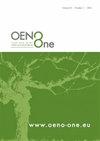在多变的天气条件下,推迟葡萄芽的生长以防止春季冻害对伦伯格葡萄酒风味化合物的影响
IF 2.2
3区 农林科学
Q3 FOOD SCIENCE & TECHNOLOGY
引用次数: 1
摘要
通过葡萄栽培管理措施延缓葡萄发芽是一种很有前途的方法,以防止春季冻害的小葡萄园。然而,在寒冷的气候地区,延迟发芽可能会延迟果实的发育和成熟,对葡萄酒质量产生负面影响。在这项为期三年(2017-2019)的研究中,我们评估了延迟发芽对葡萄(Vitis vinifera c.v. Lemberger)葡萄酒挥发物和非挥发物成分的影响,并将处理对葡萄酒成分的影响与消费者感知联系起来。我们还评估了不同年份的处理影响是否相似,或者季节性天气条件对葡萄酒成分的影响是否比延迟发芽更重要。我们每年评估四种处理:对照(C)(不使用延迟发芽策略),在休眠(A8, A10)期间以8%或10% (v/v)浓度使用植物油佐剂(Amigo®),以及在顶芽(LP)发芽后不久(1-4片叶子展开)进行后期修剪。在三年中,处理和C级葡萄之间的发芽延迟从5天(A8, 2017)到23天(LP, 2017)不等。此外,浆果颜色变化(用于评估vsamrireason的参数之一)每年在LP葡萄中比在C葡萄中开始晚。在每个年份中,我们发现延迟发芽处理的葡萄酒,特别是LP,几种挥发性化合物的浓度低于C葡萄酒。此外,与C级葡萄酒相比,LP葡萄酒的单体花青素含量往往更高,从18%(2019年)到36%(2018年)不等。消费者歧视测试的结果广泛反映了葡萄酒化学成分的差异:消费者认为LP葡萄酒与C或A8葡萄酒不同,这取决于年份,2019年所有处理方法都不同。然而,我们发现年份对葡萄酒成分的影响大于延迟发芽处理。在每年检测到的49种挥发性和非挥发性化合物中,约有一半表现出显著的复古效应,而只有三种处理方式始终不同。总之,我们的研究结果表明,在寒冷的气候条件下,延迟葡萄藤发芽会影响葡萄酒的化学成分和感知,特别是如果物候上的延迟仍然存在于vsamareason附近;然而,季节性天气条件仍然是葡萄酒化学成分的一个更重要的驱动因素,而不是物候发展的相对较小的变化。本文章由计算机程序翻译,如有差异,请以英文原文为准。
Delaying grapevine budbreak to prevent spring freeze damage impacts Lemberger wine flavour compounds under variable weather conditions
Delaying grapevine budbreak through viticultural management practices is a promising method to prevent spring freeze damage for small vineyards. However, in cool-climate regions, delaying budbreak can potentially delay fruit development and maturation, negatively impacting wine quality. In this three-year study, 2017–2019, we evaluated the impacts of delaying budbreak on wine volatile and nonvolatile composition for Vitis vinifera c.v. Lemberger at a cool-climate site, and we related treatment impacts on wine composition to consumer perception. We also assessed if treatment impacts were similar across vintages, or if seasonal weather conditions were more important for wine composition than delaying budbreak. We evaluated four treatments each year: a control (C) (no delayed budbreak strategy applied), a vegetable oil-based adjuvant (Amigo®) applied at either 8 % or 10 % (v/v) concentration during dormancy (A8, A10), and late pruning conducted shortly after budbreak (1–4 leaves unfolded) of apical buds (LP). Delays in budbreak between treatments and C vines ranged from 5 days (A8, 2017) to 23 days (LP, 2017) across the 3 years. Furthermore, berry colour change, one of the parameters used to assess véraison, started later in LP vines than in C vines each year. Within each vintage, we found that delayed budbreak treatments, especially LP, had lower concentrations of several volatile compounds than C wines. Furthermore, LP wines tended to have higher monomeric anthocyanins relative to C wines, ranging from 18 % (2019) to 36 % higher (2018). Results from consumer discrimination testing broadly reflected differences in wine chemical composition: consumers perceived LP wines as different from C or A8, depending on the year, and all treatments were different in 2019. However, we found that vintage impacted wine composition more than the delayed budbreak treatments. Of the 49 volatile and nonvolatile compounds detected every year, about half showed significant vintage effects, while only three were consistently different by treatment. Together, our results suggest that delaying grapevine budbreak at a cool-climate site can impact wine chemical composition and perception, especially if phenological delays are still present around véraison; however, seasonal weather conditions remain a more important driver of wine chemical composition than relatively small changes in phenological development.
求助全文
通过发布文献求助,成功后即可免费获取论文全文。
去求助
来源期刊

OENO One
Agricultural and Biological Sciences-Food Science
CiteScore
4.40
自引率
13.80%
发文量
85
审稿时长
13 weeks
期刊介绍:
OENO One is a peer-reviewed journal that publishes original research, reviews, mini-reviews, short communications, perspectives and spotlights in the areas of viticulture, grapevine physiology, genomics and genetics, oenology, winemaking technology and processes, wine chemistry and quality, analytical chemistry, microbiology, sensory and consumer sciences, safety and health. OENO One belongs to the International Viticulture and Enology Society - IVES, an academic association dedicated to viticulture and enology.
 求助内容:
求助内容: 应助结果提醒方式:
应助结果提醒方式:


